Ladybirds or lady beetles belong to the widespread family of Coccinellidae. Mostly called ladybugs in the USA, these beetles are not technically bugs. And ladybug larvae you might not recognize at all!
More than 5000 species of ladybugs have been identified worldwide including 500 species in the USA. Each with its own unique larvae. Let’s learn more about them…
Ladybug Larvae. The newly hatched juvenile ladybug is called a larva. The alligator-like larva has an elongated body and spiky exoskeleton. Ladybug larvae have a big appetite. A single larva can eat dozens of aphids in a day. Ladybug larva usually goes through four ‘instar’ stages before becoming an adult ladybug.
Let’s get into the details…
About Ladybug Larvae
As with many things in nature, ladybug larvae come in a multitude of different shapes, forms, and colors. Because of their appearance, it’s often difficult to identify them as ladybug larvae. These tiny predators are spiny and dark with bright markings on their bodies.
They might appear to be fearsome, but these tiny colorful larvae are harmless. They’re voracious aphid eaters, that’s why farmers and gardeners are fond of them.
The identification guide is further down the topic, but here let’s start from the beginning …
Ladybug Larva Anatomy
When the ladybug eggs hatch, a single small larva emerges. It has an elongated and segmented body of around a quarter to a half-inch in length, mostly dark in color and usually with some form of bright markings.
The color and form of larva differ from species to species. More on that is below.
It has three pairs of legs attached to the thorax. The spikes present on the larva’s body may be flexible. The Head is well developed, and mandibles are strong enough to munch on plants or aphids.
The thorax is divided into three segments, called pronotum, mesonotum, and metanotum respectively. The abdomen has 9 small segments, with a ninth segment being the tale. See Fig 1. below For the names of each area of the anatomy
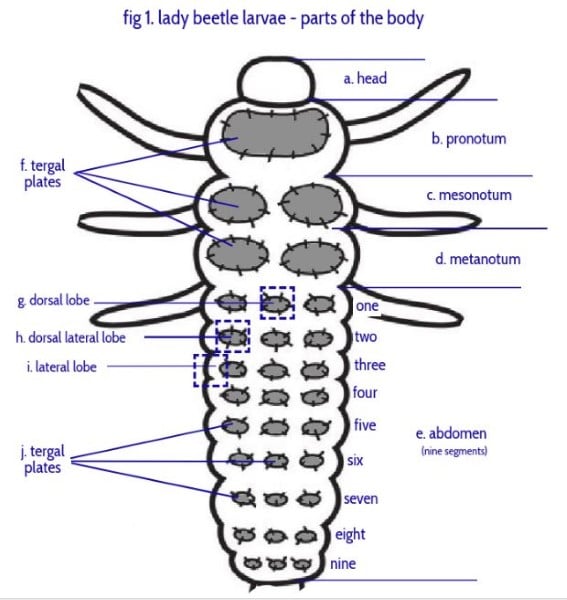
Lady Beetle Larvae – Named Parts of the Body
a. head
b. pronotum
c. mesonotum
d. metanotum
e. abdomen
f. tergal plates
g. dorsal lobe
h. dorsal lateral lobe
i. lateral lobe
j. tergal plates
Ladybug Larvae Stages
After the eggs have been laid, larvae will emerge from the eggs in about four days. The time period for this may increase or decrease, depending on the species and other environmental variables – such as temperature and humidity.
When the larva hatches from its egg, it is said to be in its first instar. The first instar larva gives the impression of being most restricted in its movement and suffers a high mortality rate. Once the cuticle hardens, the larva will begin to locate food and, eat and then eat some more!
The larva has one to one and a half days to find its prey, if unsuccessful in doing so, the larva will die.
Ladybug larvae usually molt through four instars or larval stages. An instar is a developmental stage that occurs between each molt or ecdysis. After every instar, the larva sheds its previous exoskeleton and builds up a new one, greatly increasing in size.
The larva then enters the second instar and the process goes on until the larva is ready to pupate and metamorphose. When in the fourth larval instar it is fully grown and attaches itself to a well-sheltered place to begin forming into a pupa.
Before shedding its final skin, the larva stops moving or eating and attaches itself to a surface with the help of anal pads.
Molting starts at the head and proceeds dorsally at the thorax and abdomen. After shedding its cuticle, the larva liberates itself from the shell and starts to move when its cuticle hardens.

How Long Are They Ladybug Larvae For?
The larval stage begins from the moment the larva hatches from its egg. What crawls out of the egg looks absolutely nothing like the sweet, spotted adult ladybugs they will soon become. After stepping out of the egg, the larva’s first job is to acclimatize, then find food to dine on.
Since female ladybugs lay eggs near colonies of aphids and other bugs, the baby larva gets to feed on aphids and other soft-bodied insects, providing a good start in life.
Ladybug larvae usually stay larvae for around three to four weeks, enough time to eat up as many aphids as possible and to store enough energy for the next stage.
LIFECYCLE EDUCATION RESOURCES – The ultimate way to study the ladybug life cycle in the classroom or at home is with the Ladybug Land Habitat. This whole pack provides you with the instructions and enables you to monitor the growth patterns of Ladybug from Larva to Adult.
If you cannot find it locally then It’s available here on Amazon. Also as an add-on, you can get the four models of the lifecycle to go with it.
How to Identify Ladybug Larvae
You may have seen the larvae of ladybugs munching on aphids in your garden and wondered what those tiny monsters were – or assumed that anything which resembles them must be a bad guy.
Everyone recognizes ladybugs immediately because of their brightly colored and spotted bodies, but unfortunately, the baby bugs go unnoticed due to their entirely different appearance as compared to adult ladybugs.
Instead of bright red or orange bodies and black dots, they look like tiny black alligators with spots and spines – and I’m sure you wouldn’t want an alligator look alike, crawling on your plants.
Look carefully before you spray pesticides everywhere and trust us the last thing you would want to do is kill these extremely harmless and beneficial garden allies before they fully grow into adult ladybugs.
The first step in the identification of a ladybug larva is to know, what does a ladybug larva look like?
Larvae come in a variety of forms and colors, depending on the species of ladybug, to which they belong. However, a ladybug larva is about ½ inch in length with an elongated and spiky body. They have more prominent legs which they use to walk rather than crawl, unlike other insect larvae.
Here’s where you can identify the larvae of some common ladybug species. Below each description is an image of the larva, then an image of what the adult will likely look like once it’s emerged from the Pupa stage.
Larvae of Common Ladybug Species
Seven Spotted Ladybug Larvae
The Seven-spot ladybug is the most common and widely known ladybug. The larvae of seven spotted ladybugs are elongated black in color with tiny hair-like spines perfectly aligned on the body.
A notable feature that helps identify seven-spotted ladybug larvae is colored markings. Three or four pairs of yellow or orange colored markings are present on the abdomen laterally. See also pictured below the final adult image these larvae will become.
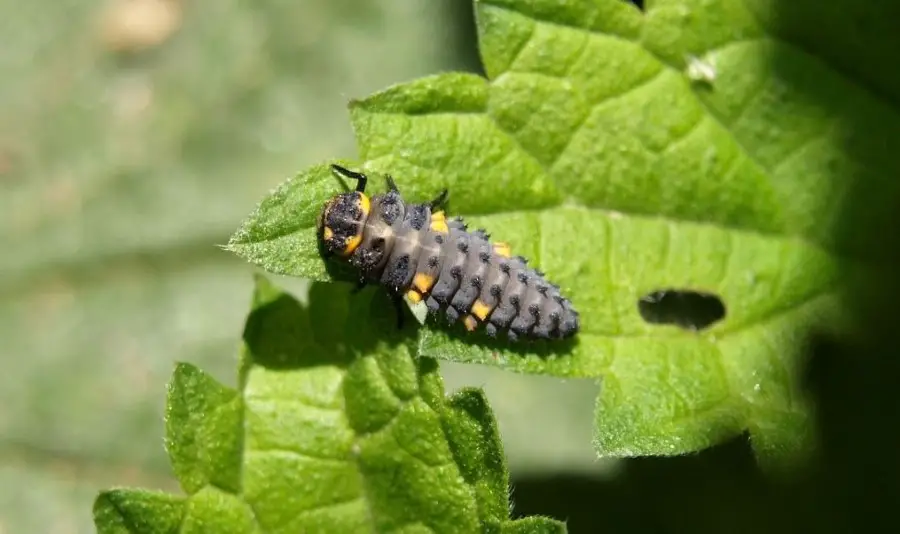

Harlequin Ladybird / Asian Lady Beetle Larvae
Harlequin ladybug, Japanese ladybug, Halloween ladybug, Asian ladybug, or more scientifically correct Harmonia axyridis is a species of ladybug native to Eastern Asia. It was introduced to North America as a biocontrol against plant-destroying pests. Note: the adult form shown below is an example, as they can come in a variety of colors


The newly hatched larva of the harlequin ladybird is dark grey with black short scoli (external spine having multiple points). Yellow or orange-colored scoli are present on the upper side of the first abdominal segment extending to the fifth abdominal segment, making an L shape on each side.
Four orange
Fourteen Spotted Ladybug Larvae
P14 or chessboard ladybug is another name for fourteen spotted ladybugs. Larva fourteen spotted
The most important identification feature is small pointed projections from the last abdominal segment. The larva is quite smooth only small hair-like projections are present on the body, but no spines.


larva image source: By Gilles San Martin – Flickr: Propylea quatuordecimpunctata larvae, CC BY-SA 2.0,
You might also find these when identifying a yellow ladybug.
Two Spotted Ladybug Larvae
Two spot ladybug larva is dark grey in color with black mounds on upper body segments. There are white patches on its grey body. Pair of central struma on segment number four and a pair of lateral white-yellow struma on the first abdominal segment can also be identified.


larva image source: naturespot.org.uk
Orange Ladybug Larvae
Halyzia

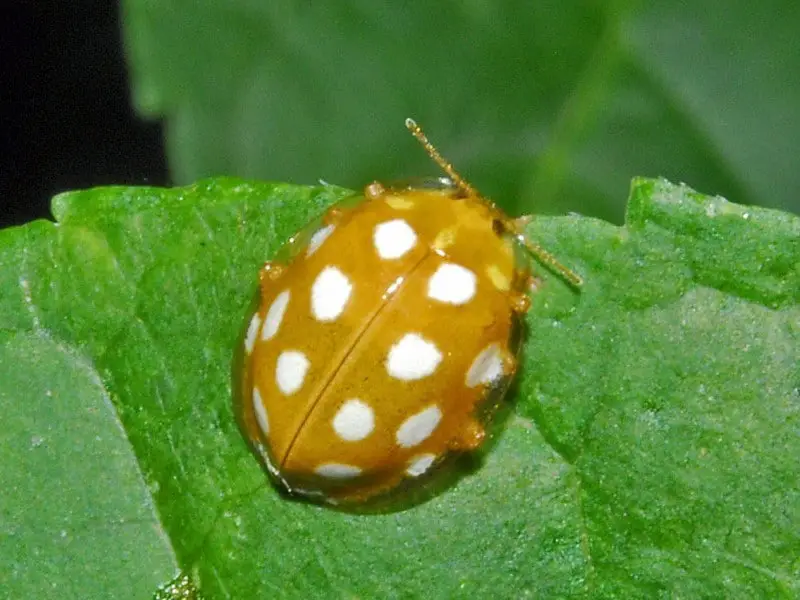
larva image source: frog end wildlife
adult image source: Hectonichus [CC BY-SA 4.0], via Wikimedia Commons
Cream Spotted Ladybird Larvae
Cream spotted ladybird, as the name suggests, has cream spots on a brownish-red body. The larva is darkish brown and elongated with two pale markings, branched spines, and the presence of hair on the abdomen.
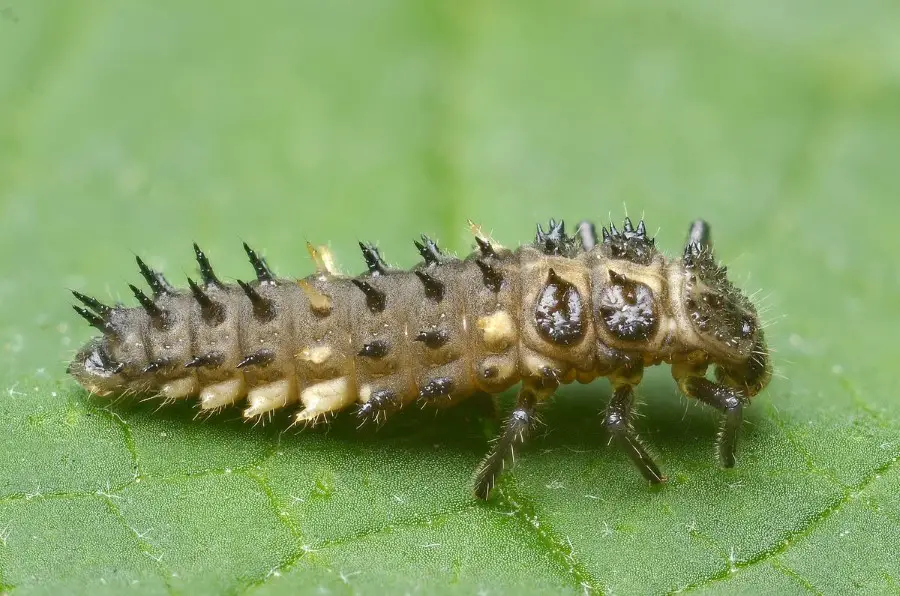

larva image source: By Gilles San Martin [CC BY-SA 2.0], via Wikimedia Commons
adult image source: By James Lindsey at Ecology of Commanster [CC BY-SA 2.5], via Wikimedia Commons
Kidney Spot Ladybug Larvae
This ladybug is absolutely beautiful with its shiny black dome and two red kidney-shaped spots on its back. But the larvae of kidney spot ladybugs look rather fearsome and dangerous.
Due to its slightly different appearance, as compared to other larvae, it can be identified easily if you look closely and carefully. Larvae of kidney spot ladybugs are dark, elongated, and spiky. The body is covered with long branched bristles.
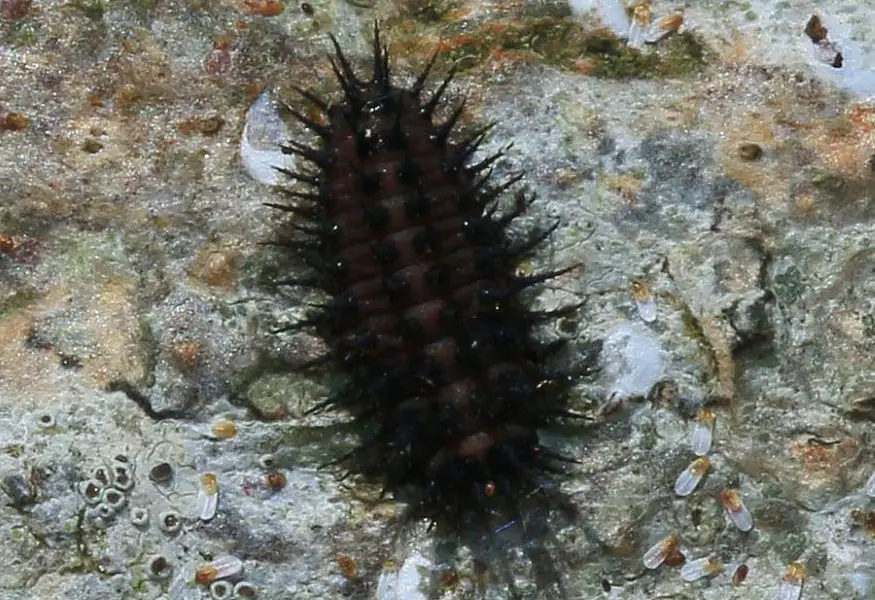
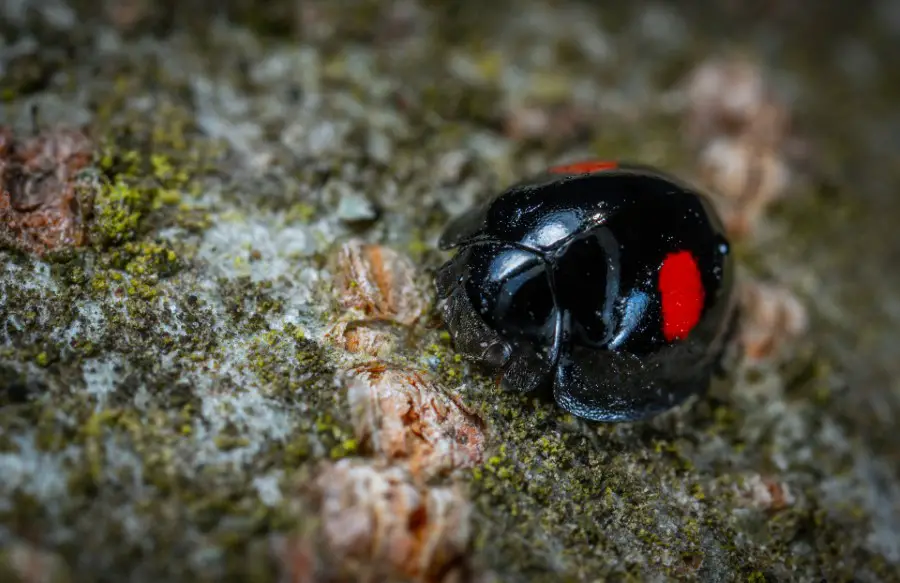
larva image source: flickr
Twenty Two Spot Ladybug Larvae
Officially called the more complex name of Psyllobora


adult image source: Olei [CC BY-SA 2.5], via Wikimedia Commons
Twenty Four Spot Ladybug Larvae
The larvae of the twenty-four-spot ladybug are pale greenish-grey with darker spikes. The spikes present on the body are finely branched. These spikes are also present in their pupal form to help protect pupa from predators.


larva image source Gilles San Martin [CC BY-SA 2.0], via Wikimedia Commons
adult image source: By Luis Miguel Bugallo Sánchez – Own work, CC BY 3.0, Link
Ten Spot Ladybug Larvae
Ten spot ladybug larva is pale with black marks on its body. Two orange spots can be identified laterally on the first abdominal segment and a central orange spot on the fifth segment. Note: the adult form given below is is an example only and can actually come in a variety of colors.


adult image source: By Bob Ionescu – self-made by author, Attribution, Link
Pine Ladybird Larvae
Exochomus


larva image source: By Gilles San Martin from Namur, Belgium [CC BY-SA 2.0], via Wikimedia Commons
adult image source: By ©entomart
Variegated Ladybug / Adonis Ladybird Larvae
variegated ladybug or Adonis ladybug or you may as well call it Hippodamia variegate. The greyish-brown larva of the Adonis ladybug has an orange-marked thoracic segment. The first abdominal segment has orange marks on the lateral side.


larva image source: eakringbirds
adult ladybug image source: Gilles San Martin from Namur, Belgium [CC BY-SA 2.0], via Wikimedia Commons
Heather Ladybug Larvae
Scientifically called Chilocorus
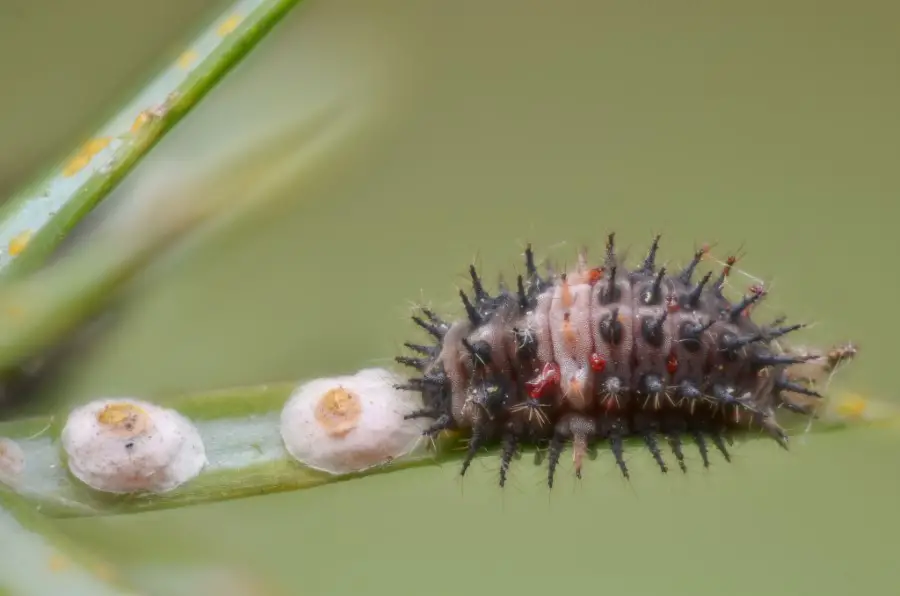

larva image source:
adult ladybug image source: Charles J Sharp [CC BY-SA 4.0], via Wikimedia Commons
Twice Stabbed Lady Beetle Larvae
Chilocorus stigma is the twice-stabbed ladybird. Named so as it appears to have the image of being stabbed on both sides. However, you wouldn’t necessarily know it, aside from two small markings between the third and fourth segments over a brown-colored body.
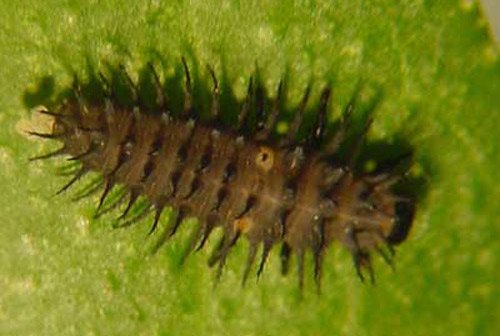
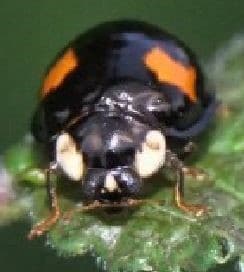
larva image source: entnemdept.ufl.edu
I hope you found and identified the Ladybird Larvae you might be looking at.
What Do Ladybug Larvae Eat?
Many people think only the spotted red ladybug eats aphids and other bad bugs, but that’s not entirely true. Although ladybugs do dine on aphids and other pests, they don’t eat as much in their adult form daily as ladybug larvae – which are enthusiastic predators of aphids and other soft-bodied troublemaking insects.
Larvae, due to their spiky, miniature alligator-like appearance, are often mistaken as garden pests. Like adult ladybugs, larvae also gobble up mites, scales, aphids, mealybugs, and other soft-bodied insects. a single larva can eat dozens of aphids per day.
They are 100% carnivorous and in their eating frenzy, they might even eat other ladybugs too. Yes, you heard it right. Ladybug larvae show cannibalistic behavior. Larva in its first instar gobbles up other unfertilized eggs, which is advantageous in terms of fast growth and development, and if food is scarce they may even turn on each other.
Larvae feeding on unfertilized ‘dummy’ eggs left by the mother have a greater probability of survival compared to those just eating aphids. This clearly shows that eggs offer high nutritional value.
As the larva grows and reaches the second or third instar. Its eating preference gradually changes from anything it needs to get – to aphids.
LIFECYCLE EDUCATION RESOURCES – The ultimate way to study the ladybug life cycle in the classroom or at home is with the Ladybug Land Habitat. This whole pack provides you with the instructions and enables you to monitor the growth patterns of Ladybug from Larva to Adult.
If you cannot find it locally then It’s available here on Amazon. Also as an add-on, you can get the four models of the lifecycle to go with it.

How Long Does It Take for a Larva to Mature into a Ladybug?
Female ladybug lays eggs usually in clusters of around 10-15, mostly near the colonies of aphids or other sources of food, and more often than not, on the underside of leaves to protect them from any possible predators.
Within a week, the eggs hatch, and what comes out looks more like a tiny dragon or alligator, called a larva. As soon as the larva emerges, it starts gobbling down aphids and other insects. the larva will eat up to 400 aphids in 2 to 3 weeks of its larval stage.
The larva will now attach itself to a leaf and pupate. In about a week the pupa will transform into a beautiful little ladybug. The life cycle of a ladybug, from eggs to mature adult, takes 4 to 8 weeks depending upon the species and environmental variables.
Although the ladybug larva looks nothing like a mature adult ladybug, it’s still a beneficial insect and our garden ally. They’re great predators of aphids, scales, mealybugs, and other pests.
Are Ladybug Larvae Beneficial Insects?
Larvae are completely harmless to our gardens and plants, in fact, they help keep a check on all those harmful pests slithering around on our plants. As Larvae, they spend most of their days eating pest insects until they eventually grow, pupate, and emerge as adult ladybugs.
Do Ladybug Larvae Bite?
Any pain or discomfort caused by a Ladybug larva bite would mostly be short-lived, as Ladybugs don’t inject any venom or toxins. These tiny bites are rarely felt; if they are, they will feel like a faint pinprick on the skin. If you’re in any doubt, or it causes anything more than a minor irritation, then seek medical advice.
Asian ladybugs certainly bite. Asian ladybug larvae are more likely to bite people too, but it’s mainly just by way of scraping the skin they land on.
Some people report having been infected by a ladybug bite, especially Asian ladybugs. But in general, a Ladybug bite does not seriously injure humans or spread any disease or allergies. If you ever get bitten by a ladybug or its larvae, don’t panic and just wash the area where you’ve been bitten. i

What Are White Ladybug Larvae?
If you see a white ‘hairy’ bug, on the underside of leaves or stems, don’t panic – before you murder one of nature’s masters of disguise, read carefully because it’s not what you think it is.
Larva of ladybug
A single larva may consume 3,000 scale nymphs to complete its development. The white waxy larva of hyperaspis produces wax from specialized glands, lining laterally.
Hyperaspis is a large genus of dwarf ladybugs that feed on scale insects, aphids, and mealybugs. The larvae are covered with white wax making them look like a mealybug. The wax is not just there to style the appearance of the larva, but it reduces the chances of the larva being eaten up by other insects.
Ladybug Larvae vs Mealybug Larvae
You might be wondering How do I distinguish the larva from mealybug?”. The fairly easy method to identify the larva of this beneficial ladybug is to give it a little poke.
A Mealybug usually stays in one place and moves slowly, whilst a ladybug larva ambles away fairly quickly when disturbed. Their waxy coating also makes them almost immune to ants, as the ants cannot seem to get a good grip on them. This is ideal if they encounter ants farming aphid colonies.

Another interesting thing about these white ghost larvae is, that they don’t grow up to be white ladybugs as you might expect. This deceptive larva, when fully grown, turns into a gorgeous black beetle with two red spots. Next time you see stealthy, wax-cloaked larvae – don’t spray them with insecticides… they’re your allies.
image source: http://fieldbioinohio.blogspot.com/2012/06/more-on-tuliptree-scale.html
Here’s a short youtube video someone took of the Hyperaspis.
Ladybug Pupa Anatomy
Larva enters its final developmental stage as a pupa. Pupa covers itself in layers of molting skin. The adult ladybug inside the molting skin is called pharate. When the pharate emerges, it leaves its pupal exoskeleton behind, the skin that’s left behind is called exuvia.
Ladybug pupa is called adecticous pupa. Due to the absence of articulated mandibles, the pupa has to first shed its pupal cuticle, then with the help of the mandible and legs, escape the cocoon.
Ladybug pupa is recognized to be an exarate pupa, that is, its appendages (legs, wings, antennae, and mouthparts) are free and not attached to the cocoon. The ladybug, which comes out of its pupal shell, is pale, golden, and wet with no spots on its elytra for around the first twenty-four hours.
How Long Are Larvae A Pupa For?
A ladybug’s larva will not enter the pupa stage until it’s gained a certain weight, that’s generally around 15 milligrams.
For larvae to pupate, it’s important that they find a safe place and attach themselves to a leaf or stem of a plant. How long a pupal stage lasts usually depends upon the temperature, it normally takes three days to two weeks for the adult ladybug to emerge out of its pupal shell.
Ladybug Metamorphosis
Metamorphosis refers to the changes in form that occur in the transformation of a larva to an adult. There are two main types of metamorphosis:
- Complete metamorphosis
- Incomplete metamorphosis
Ladybugs are holometabolous insects, that is, they undergo complete metamorphosis. In this type of metamorphosis each stage of the life cycle: egg, larva, pupa, and adult – looks totally different from others.
Ladybugs lay eggs on leaves near colonies of aphids and other food sources, so their newborns can have access to food as soon as they hatch from their eggs. Once the eggs hatch, the larvae will emerge and start eating like hungry beasts. Ladybug larvae bear no resemblance to the adult parent ladybugs.
After a few days, larvae grow and molt multiple times during the process of metamorphosis. The larva attaches itself to the substrate and begins its pupal stage by curling like a ball and covering itself entirely with a layer of skin. In this stage, the pupa does not move or eat and falls asleep for some days.
At the end of the process, the color, structure, and markings on the ladybug may change completely. When the time comes, the recently transformed ladybug breaks through the pupal skin and emerges as an adult ladybug.
Here’s some time-lapse footage of the complete cycle of a Ladybug Larva to an adult…
Ladybug Larvae – Conclusion
It’s easy to see how many people could mistake these for some kind of pests, they don’t look anything like what they will eventually become. But naturally, my advice is don’t kill them, they’re really one of the best friends your garden could have and we could probably use more of them.
Related Questions
What is ladybug pupa? ladybug in its inactive form between larva and adult stage is called a pupa. In this form, the ladybug barely moves and does not eat. During this stage, they transform into adult ladybirds.
Do ladybugs live everywhere? Ladybugs can live anywhere there is a high pest insect population and provided the climate is temperate to warm. They thrive in temperate climates high in flowers and vegetation such as gardens, and in land used for crops.
Are all ladybugs female? No. there are female ladybugs and male ladybugs. It’s hard to tell them apart, but female ladybugs are slightly larger in size compared to male ladybugs. To learn more visit my article Female and Male Ladybugs, What’s the Difference.
Is a Ladybug a bug? No, although they’re called ladybugs, they’re not technically bugs. Ladybugs are beetles that belong to the order Coleoptera. Entomologists use the name lady beetle to be a little more scientifically accurate.



I have a ladybug larva that I cannot identify. It was removed from the stomach of a cane toad in Naples, FL. I have a photograph, and would appreciate your help in an identification. If you could send me an e-mail, I will attach the photograph in a return e-mail.
Thank you so much.
Thank you Susan, I’d be happy to take a look, if you could email it to